Outside Outsider Art

Labels: Highbrow
I'm an urbanist, in love with cities. I'm also a real estate agent in Los Angeles. My "beat" includes West Adams and environs, Midtown, the Echo Park empire, and the Northeast; most of L.A.'s oldest neighborhoods, several in transition, and many with undeserved reputations.

Labels: Highbrow
 Between Earth and Heaven, an exhibition devoted to architect John Lautner, is on display at the Hammer Museum.
Between Earth and Heaven, an exhibition devoted to architect John Lautner, is on display at the Hammer Museum. Would a presentation dedicated to an early Los Angeles master, a Joseph Cather Newsom or a Hudson & Munsell (second image), have any drawing power? Probably not. I might shadow such a show, transfixed by albumen prints, a scrap of Herter Brothers paper, and Gilded Age analysis, whilst my set, my "peeps"--nearly everyone with whom I have anything in common--every cosmopolitan, Obama supporting, greenified, Whole Foods Shopping khaver between 28 and 61 years of age--toured the Mar Vista tract, shopped for Scandinavian furniture, bubble lamps, and all things bent ply.
Would a presentation dedicated to an early Los Angeles master, a Joseph Cather Newsom or a Hudson & Munsell (second image), have any drawing power? Probably not. I might shadow such a show, transfixed by albumen prints, a scrap of Herter Brothers paper, and Gilded Age analysis, whilst my set, my "peeps"--nearly everyone with whom I have anything in common--every cosmopolitan, Obama supporting, greenified, Whole Foods Shopping khaver between 28 and 61 years of age--toured the Mar Vista tract, shopped for Scandinavian furniture, bubble lamps, and all things bent ply. Afterwards I'd attempt to pass unnoticed, as the mod throng toasted and made Luau fun around the Tiki firepit, "admit it", they'd hasten, "you like amoeba shapes, post-and-beam construction, and the Rat Pack."
Afterwards I'd attempt to pass unnoticed, as the mod throng toasted and made Luau fun around the Tiki firepit, "admit it", they'd hasten, "you like amoeba shapes, post-and-beam construction, and the Rat Pack."Labels: Highbrow
 Sometimes paint colors, the crowning touch in many restorations or remodels, endures a drawn-out coronation. Half-painted walls languish for months, swatches taped in the corners of rooms, sample after sample brushed over stark white primer.
Sometimes paint colors, the crowning touch in many restorations or remodels, endures a drawn-out coronation. Half-painted walls languish for months, swatches taped in the corners of rooms, sample after sample brushed over stark white primer. According to Louis Marchesano, a curator at the Getty Research Institute, the choice of color is made by either the designer or the curator, and is usually a stock color widely available. "I've even thought we should include a color attribution in our exhibition materials," says Marchesano, "though the designers keep a complete record of all the materials used."
According to Louis Marchesano, a curator at the Getty Research Institute, the choice of color is made by either the designer or the curator, and is usually a stock color widely available. "I've even thought we should include a color attribution in our exhibition materials," says Marchesano, "though the designers keep a complete record of all the materials used."Labels: Highbrow

Labels: Highbrow
 A detail from Hunters in Snow, featured memorably in Andrei Tarkovsky's severly haunting film Solaris (inexplicably re-made as a George Clooney vehicle). Probably Brueghel's first winter landscape. Blacksmiths toil as the huntsmen and hound return amidst fading light. The hillside is lined with houses of masonry construction, many with a jerkinhead, or clipped gable roof.
A detail from Hunters in Snow, featured memorably in Andrei Tarkovsky's severly haunting film Solaris (inexplicably re-made as a George Clooney vehicle). Probably Brueghel's first winter landscape. Blacksmiths toil as the huntsmen and hound return amidst fading light. The hillside is lined with houses of masonry construction, many with a jerkinhead, or clipped gable roof. The Numbering at Bethlehem was signed and dated 1566. Elsewhere in the picture, the Imperial tax gatherers have established themselves at an inn, to collect duties as pigs are slaughtered, children play, and the drama of the Nativity unfolds. (Brueghel was about 40 when the Duke of Alba led Spanish forces into Brussels to forcibly convert the Protestants). In the center, a two story structure with a stepgevel and a second-story sand colored addition commands attention. Seen through bare branches, the red, winter sun nears the horizon.
The Numbering at Bethlehem was signed and dated 1566. Elsewhere in the picture, the Imperial tax gatherers have established themselves at an inn, to collect duties as pigs are slaughtered, children play, and the drama of the Nativity unfolds. (Brueghel was about 40 when the Duke of Alba led Spanish forces into Brussels to forcibly convert the Protestants). In the center, a two story structure with a stepgevel and a second-story sand colored addition commands attention. Seen through bare branches, the red, winter sun nears the horizon.
Labels: Highbrow
 This painting by Henri Matisse is in the Phillips Collection. I was especially drawn to its elemental geometry and depth, the view from the lofty studio, of the Seine and the Pont Saint-Michel, and the blue roof of the Louvre.
This painting by Henri Matisse is in the Phillips Collection. I was especially drawn to its elemental geometry and depth, the view from the lofty studio, of the Seine and the Pont Saint-Michel, and the blue roof of the Louvre.Labels: Highbrow

Labels: Highbrow


Labels: Highbrow


Labels: Highbrow


Labels: Highbrow




Labels: Highbrow